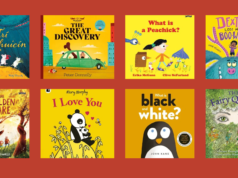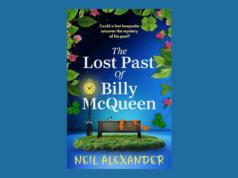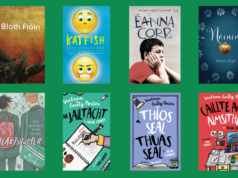Jane Mitchell’s book A Dangerous Crossing tells the story of Ghalib, a young Kurdish boy fleeing the Syrian civil war.
Over the last few years, news reports have been replete with harrowing images of distressed children and of desperate families in overcrowded, leaky craft, tossed in the open sea. We read about people rescued by international naval vessels in the Mediterranean (including our own LÉ Niamh), of small bodies fished from the deep, of deflated boats and lost families. We listen to political rhetoric and decide for ourselves whether these people are desperate refugees or economic migrants; whether they should be allowed into Turkey, the EU or Ireland; or whether we should close our borders, like some European countries have done. In these times of massive cultural and political change, we struggle to make sense of the greatest migration since World War II. We wonder what the ultimate result will be, and what our world will look like when populations settle once again.

My book focuses on the small— not on geopolitical manoeuvres, not on global war, not on the mass migration of populations, but on one boy. As war blazes around him, Ghalib escapes his home town of Kobani with his family to Turkey, and from there to Europe. Like so many Syrian families, Ghalib’s doesn’t want to leave their home or their extended family. They had a good life before the war; being a streetwise thirteen year-old, Ghalib still manages to have good times even during the war. While his story is of interest to readers of all ages, the book is primarily aimed at 12–14-year-olds.
Understanding such global upheaval can be confusing and difficult for adults. Children and teens are perhaps more challenged, as their inexperienced and developing minds grapple with complex political shifts bringing radical changes at an unprecedented pace. In Irish schools, teachers discuss these issues in CSPE and Religion classes, but how do we explain what we ourselves find difficult to understand? Regardless of our age and experience, it is often easier to make sense of something when it is presented on a personal level: we can all identify more easily with one person’s story. In A Dangerous Crossing I have put a face and a name on one of the thousands of refugees seeking safety.
It is tempting to shield children from life’s harsher realities, such as death and war, but children have a remarkable capacity to empathise when something is presented in a way they can understand. With media coverage of the civil war, they are already aware of the crisis but perhaps don’t quite appreciate what it means. I believe that children in Ireland and the UK need to, and are entitled to, understand the terrible things that are happening to Syrian children. I believe passionately that words have the power to create empathy, to engender understanding and to provoke action. The more young people learn about this crisis, the more they might understand its underlying causes and begin to comprehend what is happening to young people their own age. More importantly, they will have a greater understanding of what is happening in the world, a world which is theirs as much as ours.
Fiction can be a wonderful medium through which to explore difficult topics. An honest story-line that doesn’t shy away from the truth enables young readers to explore multiple perspectives and gain insight into complex issues. Nevertheless, when writing a distressing story, I try to remain sensitive to the young reader. It can’t all be bleak, so I include a note of optimism and hope, even a touch of humour. Having previously been a teacher and worked with children and young people with disabilities, I try to ensure that the language and narrative are appropriate to engage young readers. Their imaginations will fill out the details and carry them far beyond the words on the page, so there’s no need to include every grim fact.
Research for this book was very important because accuracy creates a more believable narrative. That, however, brought its own challenges. While travel to the country was impossible, I needed to visualise Syria in order to portray a credible setting for the family to live in and travel through. The sights, the towns and villages, the food and the landscape are central to the story. I drew on my previous travels to the region: hillwalking and trekking in south Turkey, and encountering the rich culture and people of Palestine, Jordan and Egypt. While each of these countries is unique, they also have threads in common with Syria that I sought to draw together.
I met a Syrian family who moved to Dublin before the civil war. They told me about pre-war Syria, and provided great insight into life for young people there, including education, food and lifestyles. From them I learned about small local bakeries, corner shops and greengrocers; about family investments in orchards, property and gold. And I understood for the first time the ongoing anguish of the Syrian diaspora who have friends and family still living in the war zone.
Finally, I volunteered for a week in the Jungle Camp in Calais, where I saw first-hand the terrible conditions in which illegal refugees survive, with inadequate shelter and appalling sanitation. I met refugees from Eritrea, Sudan, Afghanistan, Iraq, Libya and Syria. I was there when French police launched a tear-gas attack: a frequent event. These attacks caused panic and distress, as well as physical pain and discomfort—an experience I recreated for Ghalib during his ordeal. Although I deeply respected the people in the Jungle Camp and was there in solidarity with them, I was conscious that my brief involvement was not based on an equal relationship. These vulnerable people are at a low point in their lives and deserve their dignity: I only drew on what I saw to enrich the narrative of the story. None of their personal experiences are included.
At the end of the book, I acknowledge that the name of every fictional character in it comes from an actual Syrian child who died in the civil war. Hundreds of innocent children have been killed and I wanted to remember them in some small way. I found out their names from the Syrian Network for Human Rights and hope this brings an emotional connection between the reader and those lost Syrian boys and girls. I hope, too, that it engenders as powerful a response in the reader as it did in me when I wrote down these dead children’s details. While a work of fiction, my book is based on real lives and echoes the daily horrors faced in Aleppo, Kobani, Raqaa and other Syrian cities.
It is important for this story to be told so that our children can really see what life is like for children in a war-torn country. The terror, the fear and the worries that Ghalib and his family endure are genuine. It is sometimes easy for us to separate what we see in newspapers and on television from our own lives—yet this is happening now. Young people deserve to learn about the world in which they live, and about the shocking reality of war.
First published: Books Ireland magazine (January/February 2017).











